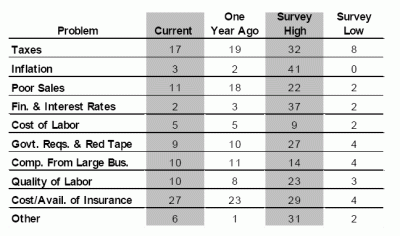
| ABOUT | ||
| SMALL BUSINESS TRENDS brings you daily updates on trends that influence the global small business market. | ||
 |
Anita Campbell, Editor | |
| Past life: CEO, corporate executive, tech entrepreneur, retailer, general counsel, marketer, HR ... (more) | ||
| email me | ||
 |
 |
||
| FREE BUSINESS MAGAZINES | ||
| Trade publications FREE to qualified professionals. No hidden offers and no purchase necessary. | ||
|
On Wall Street The Deal Computing Canada |
CIO Employee Benefit Oracle Magazine |
|
| 100+ additional titles. Click to browse. | ||
 |
| ARCHIVES & SEARCH | |||
| Previous Small Business Trends articles can be found at the links below: | |||
|
October 2003 November 2003 December 2003 January 2004 February 2004 March 2004 April 2004 May 2004 June 2004 July 2004 August 2004 September 2004 October 2004 November 2004 December 2004 January 2005 February 2005 March 2005 April 2005 May 2005 June 2005 July 2005 August 2005 September 2005 October 2005 November 2005 |
|||
|
Or, use the search box below to find a specific post: |
|||
 |
| NEWSLETTER |
| Sign up for our FREE Small Business Trends newsletter. (View Current)
We publish regularly and promise we won't share your email address with anyone. (Privacy Policy) |
 |
 |
| SMALL BIZ INFO & RESOURCES | |
 |
| BLOGS TO READ DAILY* | |
| * Don’t have time to read several dozen blogs a day? Pick two or three. Your brain will thank you for it. | |
 |
| ONLINE COMMUNITIES | ||
 |
| SPECIAL RESOURCES | ||||
| Small Business Trends Radio Tuesdays, 1:00 PM Eastern U.S. time on Voice America network Click to listen November 1st: Torsten Jacobi, CEO of Creative Weblogging, joins host Anita Campbell. Sponsored by Six Disciplines. Show details. |
||||
| Friday, February 11, 2005 | |||||
| U.S. Small Business Optimism Remains High | |||||
The February 2005 NFIB Small Business Economic Trends Survey is out. The NFIB's Optimism Index remains at record high levels. U.S. small businesses feel good about the economy and the conditions their businesses operate under:"Overall, 2005 is looking pretty good. Outside of the spectacular run of Index readings over the past 20 months, there are few periods in the 30 year history of the NFIB survey with Index readings this strong (103.7). Job creation plans (a net 15 percent plan to increase jobs) are stronger than any registered in the great 1980s expansion. Only the late 1990s produced higher readings.Perhaps the most interesting piece of information from this report is the listing of "Single Most Important Problem," as shown in the following chart. The higher the number, the more important the problem:
So much is written about small businesses finding money, when that is their least important problem. The most important problem for small businesses in the United States, by far, is the cost of health insurance, followed by high taxes. |
|||||
|
| |||||
 |
|||||
 |
 |
||||
| More news... more trends... more insight... | |||||
| Home | Privacy | Terms | SmallBizTrends |
| (c) Copyright 2003 - 2005, Small Business Trends LLC. All rights reserved. |
